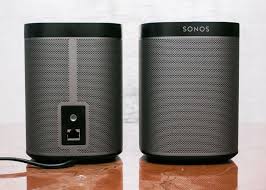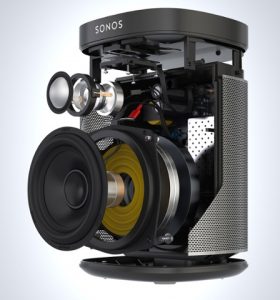If you have been reading our various router reviews (see the list here), you know we have set up several Airport Express routers to support Apple AirPlay so we could stream music into various rooms. Now that we have discovered the Sonos Play 1 Wi-Fi speaker, it may be time to rethink our strategy.
Apple Tech Talk Scorecard
| Pros | Cons |
| Easy set-up | No Airplay support |
| Large variety of free music included | No auxiliary input |
| Good sound quality |
Sonos Play 1 – Unboxing
The Sonos Play 1 is the entry level speaker in the Sonos line. In the box is the Sonos Play 1 speaker, a dedicated power cord, a flat Ethernet cable, the Sonos QuickStart Guide and the Legal/Warranty information.
The Sonos Play 1 has a solid feel. Measuring 6.36” high by 4.69” square and weighing in at 4.08 lbs. you don’t have to worry about someone knocking it off a table or shelf.
Our Play 1 came in the black finish with a graphite grill but it is also available in white with a light metallic grill.

The unit has very clean lines. The Sonos logo appears along the top on the front edge of the speaker. The top has a volume button, a Play/Pause button and a single white LED which can be turned off using the Sonos Controller app, (more on that in a minute). On the back is a standard ¼” x 20 threaded mounting socket for most standard wall mounts and speaker stands as well as a 10/100 Mbps Ethernet port for wired connection to your router (if needed).
The bottom of the unit holds the Auto-Switching 100-240 V, 50 – 60 Hz AC universal power connection and the included (U.S.) power cord has a plug molded at a 90 degree angle so that it fits flush into the bottom.
Sonos Play 1 – Set-up
We found the set-up process for the Sonos Play 1 to be quick and easy.
Once we connected the AC power and tuned on the unit, the LED on the top started to flash green.
Next we downloaded the free Sonos Controller app for our iPhone 7, from the App Store. With the app open, we selected the option to Set-up a New Sonos and used a “Standard” set-up.
The app asked us to press the Play/Pause and the “+” (Volume Up) button at the same time. This creates a temporary network for the iPhone to use to complete the set-up. When we pressed the buttons, the flashing LED turned from green to orange and the app asked us to confirm that.
As is usual for these types of devices, we now needed to go into the Wi-Fi section of our iPhone Settings and select the new Sonos network. Once that was done, we returned to the Sonos Controller app to link the Sonos to our usual Wi-Fi network, entered our network password and the Sonos Controller took care of the rest.
The final step was to name the player so we could easily identify it. We selected a name from the list provided but you can also enter your own name if you want to.
Sonos has a nice video to walk you through the entire set-up process and you can see it below.
https://www.youtube.com/watch?v=uitIT-nSrr4
We went through all of the steps quickly and without issue and the Play 1 was up and running in a matter of minutes.
Sonos Play 1 – Test Results
Admittedly, we did not fully understand how the Sonos Play 1 worked before we set it up.
We expected, as a Wi-Fi speaker that it would eliminate the need for an Airport Express but still interface with AirPlay and we could use the Sonos Play 1 along with our other AirPlay speakers. We quickly discovered that was not the case.
The Sonos system does not have Airplay built in. However, just as we have connected powered speakers to an Airport Express, you do have the ability to connect some Sonos models to an Airport Express to take advantage of Airplay. Sonos provides detailed instruction on how to do that and you can see them here.
Unfortunately, the Sonos Play 1 does not have an Auxiliary input so there is no way to make the connection to the Airport Express. But that doesn’t mean you have lost access to your music.
Adding Your Own Music Library
In addition to the iOS app, Sonos provides a Sonos Controller app for the Mac desktop, (10.9 or higher). Using the desktop app, you can add music libraries to the Sonos Controller and stream your music over your Sonos speaker.
In all, the Sonos Play 1 can support up to 16 libraries, which can be on multiple computers or as in our case, even on network attached storage like our ReadyNAS 526X (read our review here), which holds our master music library.
Sonos supports most of the audio formats supported by Apple, Playlists created in iTunes as well as album art in JPG, BMP, GIF and PNG formats up to a resolution of 1024 x 1024.
Here is a video that explains how to add your own music library to your Sonos Play 1.
https://www.youtube.com/watch?v=jUT7jqnw8hI
The Sonos Play 1 can also play any music stored locally on your iPhone or iPad and can support multiple devices connected simultaneously.
Other Music Options
If we had just gotten access to all of our music libraries we would have been satisfied, but we quickly discovered, that was only the beginning of what the Sonos Play 1 had to offer.
Included with your purchase of the Sonos Play 1 is a long list of free, premium and curated streaming services. Stations like Pandora, Spotify and Google Play Music are available at the touch of a button. If you are an Amazon Prime subscriber, you get free access to Amazon Prime Music. Just enter your Amazon account credentials and you are connected to millions of songs and playlists.
You can see a complete list of the current Sonos streaming services available here, and the list keeps growing.
If Internet Radio is more to your liking, Sonos includes free access to over 100,000 local and international radio stations and podcasts, with something for just about every taste.
As you discover new music channels and steaming stations that you want to return to, you can add them to your “favorites” with the click of a button and they will be saved to your list.
Updates and Support
Sonos is always working to make their products better and the Play 1 is no exception. Both the hardware and the software are designed to be updated as Sonos introduces new features so you can be comfortable that you investment will be current for a while. During our testing a new version of firmware and the Sonos Controller were released and the update process was quick and flawless and completed entirely over-the-air.
Sonos also provides a rich support site with lots of tutorials and FAQs to cover almost any issue you may run into. They also have phone and email support if you need some extra assistance. During our testing we had an opportunity to speak with a member of the technical support team. We found them to be knowledgeable and friendly and our technician addressed our question quickly.
There is also an active support community available which is well organized and helpful.
Sonos Play 1 – Sound Quality
 Sound quality is a very personal thing. What one person finds pleasing and enjoyable may be totally unacceptable to someone else. In the end, it really only matters that you enjoy what you are listening to. Based on that criteria, we found the Sonos Play 1 delivered a pleasant listening experience.
Sound quality is a very personal thing. What one person finds pleasing and enjoyable may be totally unacceptable to someone else. In the end, it really only matters that you enjoy what you are listening to. Based on that criteria, we found the Sonos Play 1 delivered a pleasant listening experience.
The Sonos Play 1 is powered by two (2) Class-D amplifiers that are tuned to match the speaker drivers and acoustic architecture. Inside is one (1) mid-range woofer and one tweeter that combine to give well balanced sound. There are no physical controls on the speaker to adjust the sound but using the Sonos Controller app you have the ability to adjust the bass and treble of the speaker.
Sonos also has a feature called Trueplay ™ speaker tuning. According to Sonos;
“Trueplay analyzes room size, layout, décor, speaker placement, and any other acoustic factors that can impact sound quality. Then it literally adjusts how each woofer and tweeter produces sound.”
Trueplay is run from the Sonos Controller app and the process involves waving your iPhone up and down while you move around the room, as the Sonos Play 1 emits a tone. The tome is analized and the speaker output is adjusted to match the room characteristics. Sonos recommends that if you change the speaker position or move it to another room, that you rerun the Trueplay process to retune the speaker.
We don’t consider ourselves audiophiles but we could definitely hear a difference after we went through the Trueplay process. We thought it sounded pretty good before but now the speaker had a much brighter sound and vocals were crisper.
The Sonos Play 1 is a “mono” speaker so just listening to our one speaker did not provide some of the dynamics that comes from listening to a fuller stereo sound. That said, the Sonos Play 1 is very versatile and if you have a second Play 1, you can use the Sonos Controller app to set them up as a left and right channel for a true stereo experience.
Using the Sonos Controller app, you also have the ability to group one or more speakers into what Sonos refers to as “Zones”. You then have the ability to play the same music across multiple zones or have each zone play something different. If playing multiple zones, you have the ability to create playlists for each zone independently as well as allow other people (on your network) to have control over their own zone. This provides a level of control we don’t have with our Airplay streaming.
During all of our testing, we did not experience any drop-outs or loss of signal. We played music from various Internet sources and from our own library for hours and the Sonos Play 1 never missed a note. We can’t say the same for the streaming over the Airport Express network.
The Bottom Line
When we first set-up the Sonos Play 1 and discovered it did not support Apple AirPlay we were extremely disappointed and didn’t expect we would have much use for it. That changed quickly once we had it set-up. The Sonos Play 1 Wi-Fi speaker provides access to all of your own music libraries plus an almost limitless variety of streaming services and Internet radio.
If you are a true audiophile you may find the sound quality of the Sonos Play 1 lacking, but we suspect that you would feel the same way about any Wi-Fi connect speak system. For everyone else, we think the Sonos Play 1 deserves serious consideration.
We have to admit, we’re hooked on the Sonos Play 1. Since we first started to use it we have not used our Airport Express system to stream music. There is so much content available through the Sonos Controller app that we are still discovering Internet radio stations and streaming service channels that we never knew existed.
Our discovery of the Sonos Play 1 is well timed.
If you consider that a current Airport Express sells for $99.00, but that doesn’t include speakers which can easily cost another $100.00 or more depending on the quality, the cost of a Sonos Play 1, with its MSRP of $199.00, seems very reasonable.
Most of our Airport Express units are the older 802.11g units and they are really starting to show their age. We recently upgraded one of then to the current 802.11n Airport Express unit to help address some of our drop-out and signal loss issues. We were considering upgrading the rest of them until the recent announcement that Apple was closing down its Airport division and reassigning the engineers to new projects. While there is no indication that the Airport product line is being discontinued, we question if we should be investing in new hardware with an uncertain future.
We do currently miss not having the music playing in multiple rooms so we will be replacing the existing AirPlay network with new Sonos Play 1 units in the near future.
The Sonos Play 1 is available from Amazon.
Are you a fan of streaming audio? What system or speaker do you use? Why not joint the conversation by leaving a comment below.
If you liked this article, please consider sharing it with your friends and leaving a comment below.
Also, don’t forget to “Like” us on Facebook, “Follow Us” on Twitter and add the Apple Tech Talk channel to your Apple News app.
APPLE TECH TALKER



[…] like our Sonos Play 1 speakers (read our review here), our Ring Video Doorbell (read our review here), and our Epson Eco-Tank ET 2760 printer (read our […]